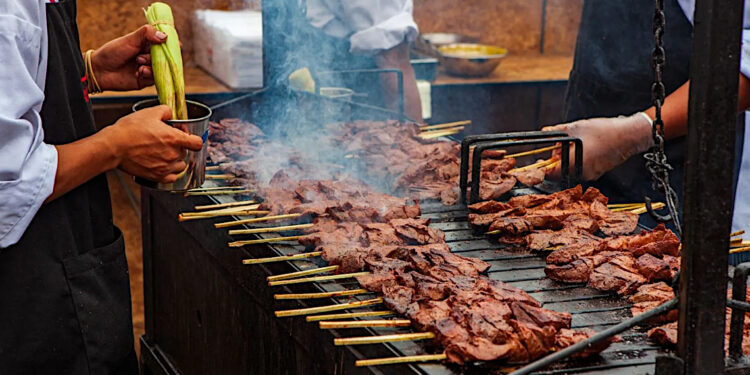Anticucho is one of Peru’s most emblematic dishes. What is now a symbol of unity and national pride began as a marginalized food, dismissed by Lima’s colonial elite and relegated to the city’s poorer areas. Today, it stands as a living symbol of Peru’s history, diversity, and flavor—a culinary legacy that transcends its humble origins to represent Peruvian street food and identity, at home and abroad. Anticucho is a heartfelt connection to the homeland, a reminder of the rich cultural heritage Peruvians share.
The Marginal Origins of Anticucho
Anticucho’s roots stretch back to pre-Hispanic times when the Andes’ original inhabitants prepared a basic version using llama meat. Grilling meat was already part of Andean cooking, with local spices like ají adding flavor. But the dish as we know it took shape with the arrival of the Spanish and the introduction of beef. In colonial Lima, prime beef cuts went to the upper classes, while the less desirable parts, like the heart, were left to enslaved Africans.
In those days, many Limeños regarded animal innards as unsuitable for eating. Anticuchos, made with beef heart, were seen as lowly street food, confined to poorer neighborhoods and alleyways. Even well into the Republic, this perception held. For Lima’s elite, Anticucho was simply a dish for the poor, cooked and sold on the city’s fringes.
Yet creativity and necessity led enslaved Africans to transform this discarded meat into something flavorful and affordable. They marinated it with ají panca, garlic, and local spices, cooking it over coals and sometimes serving it on corn husks. Anticucheros, or Anticucho vendors, roamed the streets offering the dish to anyone looking for a delicious, budget-friendly meal.
Anticucho Hits the Streets: Corn Husks and Grills
For centuries, Anticucho became the ultimate street food, cooked and sold by vendors at makeshift stalls. Initially, corn husks served as plates, making it easy to carry and sell on the go.
As Lima’s population grew, Anticucho’s popularity spread beyond the poorest neighborhoods. The dish’s distinctive marinade of ají panca, vinegar, cumin, and other spices, combined with its grilled preparation, made it irresistible for its taste and affordability. The smell of Anticuchos grilling on makeshift barbecues wafted through city streets and plazas, attracting people from all walks of life.
Rejected by the Elite: Food of the Streets
Despite its undeniable flavor, Lima’s colonial and republican elites rejected Anticucho, viewing it as a food for the poor. In a deeply stratified society, Anticucho was seen as “low,” a street dish for those who couldn’t afford finer meat cuts. The street, with its itinerant vendors and makeshift grills, was the natural stage for this dish, with no place at elite tables.

This dismissal was also tied to the origins of Anticucho: it was a creation of enslaved Africans and the working class, a dish born from necessity and creativity during times of social exclusion. Vendors, known as Anticucheros, walked the streets selling to crowds who, for a few coins, could enjoy a hearty and flavorful meal.
Anticucho Today: A Symbol of Peruvian Cuisine
Over time, anticucho broke out of its working-class roots to earn acclaim across the country. Today, it is one of Peru’s most iconic dishes, celebrated in humble neighborhoods and high-end restaurants alike. Once a marginalized food, it has become a symbol of Peruvian culinary ingenuity and tradition.
While still a beloved street food, Anticucho’s popularity has crossed borders. During Peru’s Independence Day celebrations, Anticucho takes center stage at family gatherings and fairs. People gather around grills, where the aroma of marinade and sizzling meat mixes with the joy and pride of being Peruvian.
Anticucho has also captivated international taste buds. In cities like New York, Miami, Madrid, Amsterdam, Berlin, and London, where large Peruvian communities reside, Anticucho is a staple in restaurants and festivities. It’s a taste that reconnects Peruvians with their roots and a way to share Peru’s rich cultural heritage.
The will to win, the desire to succeed, the urge to reach your full potential these are the keys that will unlock the door to personal excellence.
Anticucho: A Dish of Heart and Pride That Unites
The recognition of Anticucho goes beyond street food. In recent decades, renowned chefs like Gastón Acurio and Virgilio Martínez have brought Anticucho to fine dining, giving it a prominent place on their menus. Despite gourmet reinterpretations, Anticucho has kept its essence: it remains a simple yet flavorful dish that pays homage to its humble origins.
In high-end kitchens, anticucho is presented with sophisticated ingredients and techniques, while staying true to its roots. This has drawn new fans, both Peruvian and international, who appreciate the dish’s flavor and the story it carries.
Anticucho is more than just a delicious dish; it’s a story of resilience and adaptation. It’s proof that a dish born of necessity and ingenuity can grow to symbolize national unity. For Peruvians and the Peruvian diaspora, Anticucho is a reminder that Peru’s cultural and culinary wealth knows no limits, and that what was once rejected is now celebrated worldwide.
Every time someone lights a grill to cook Anticuchos, they’re reviving a tradition that has survived centuries, broken down social barriers, and united generations of Peruvians, both in their homeland and abroad.
Anticucho is true national pride—a dish that embodies Peru’s history and diversity and continues to win hearts and palates around the world.




